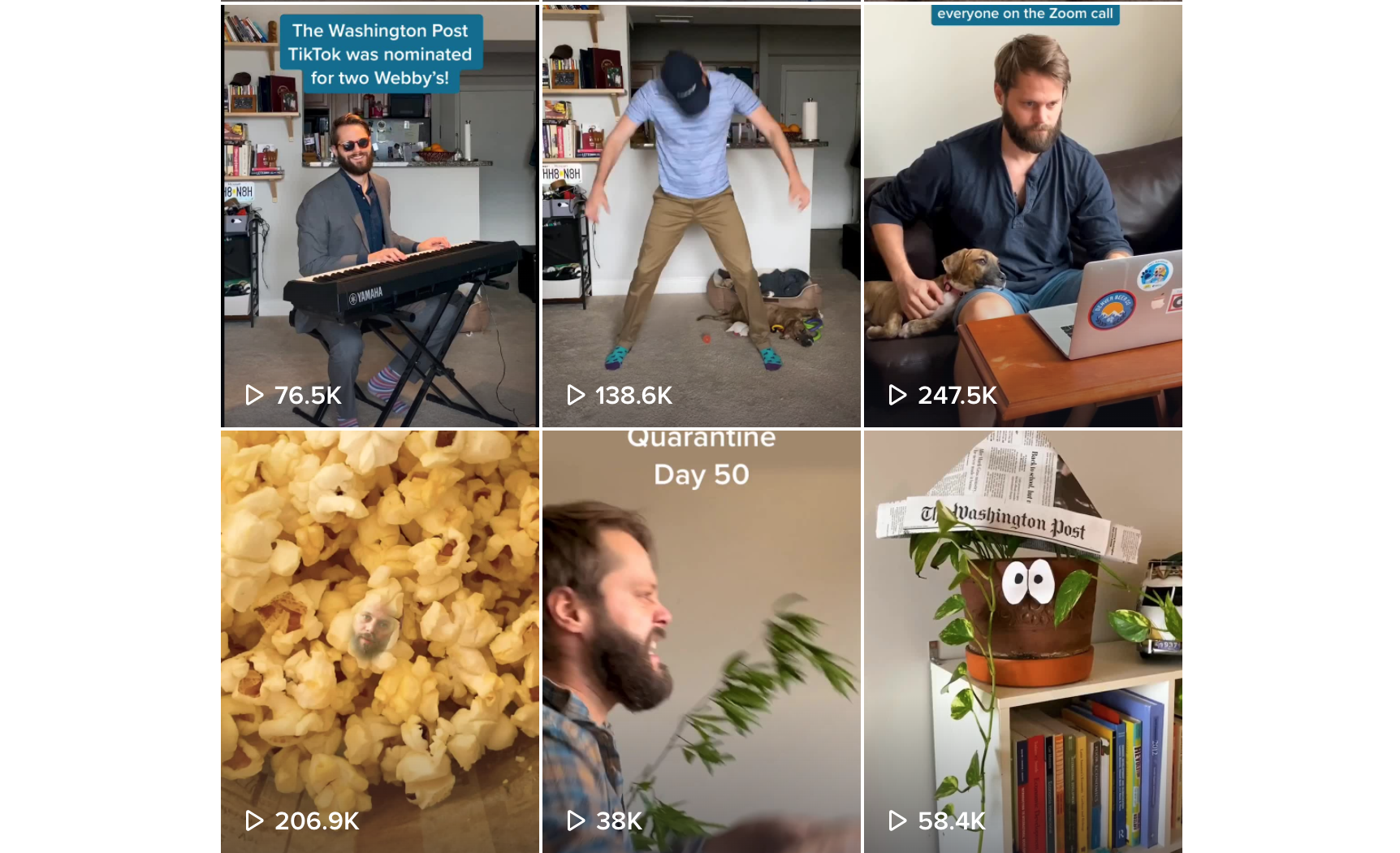
For many, the name Washington Post remains synonymous with Watergate, conjuring images of old-fashioned phones, typewriters and the dogged reporting of Bob Woodward and Carl Bernstein.
But for the Post’s half a million TikTok followers, the brand probably means something else. Since Covid-19 forced the US capital into quarantine, Dave Jorgenson – the Post’s “TikTok guy” – has been documenting life in his one-bedroom apartment with short, comedic videos.
@washingtonpostWe are sorry. ##telenovela ##thursdays♬ sonido original – pamelapancito
The clips seem to be going down well. The Washington Post’s TikTok account – which was active before lockdown – has amassed 22m likes on its videos. That’s more than Miley Cyrus, Nicole Scherzinger, Little Mix and several other celebrity accounts with larger followings have managed.
“We worry a little about him,” jokes Emilio Garcia-Ruiz, the Post’s managing editor for digital, speaking to Press Gazette via Zoom from his home (video below).
“There’s nothing more fun than what Dave is doing on TikTok,” he adds. “Into what many people think of as a stuffy, traditional newsroom, we really wanted to build a sense of experimentation. We want our content to be distributed successfully on as many platforms as possible.”
Garcia-Ruiz, who started out as a sports journalist before rising through the ranks at the Post over 19 years, has been heading up the group’s digital operation since 2013.
In that period, the title’s website traffic has rocketed. According to Comscore figures, the website recorded 139m unique visitors in March – a month when many news websites were significantly buoyed by interest in coronavirus. Back in September 2014, the Post was celebrating 42m unique digital users, which was up 47 per cent on the same period in 2013.
In common with several other major US newspaper groups, like the New York Times and Wall Street Journal, the Post has also built up a sizeable subscriber base. As a private company, the Post does not regularly release figures, but it did report having 1.5m digital subscribers as of the autumn of 2018.
On social media, as well as being active on TikTok, the Post is also on Snapchat and its main Instagram account has 3m followers. Elsewhere, its flagship podcast, Post Reports, has just recorded two record months for listenership.
“I think we will always have the legacy of Watergate,” says Garcia-Ruiz. “That will always be part of it, and… a generation will always think of us that way. What I try to impart is that what we want to do is to keep the values from back then – we want to keep the foundational bricks that were laid by those folks and build upon them in a digital world. And I think we’ve done that.”
‘Back in the day all we would do is write stories… Now we’re really trying to give our readers an experience’

Emilio Garcia-Ruiz (Photo by Marvin Joseph/The Washington Post)
Last week, while its TikTok account was gathering ever more followers, a team of Post journalists was being recognised for a series of stories on climate change that won the newspaper a Pulitzer Prize.
In all, 53 newsroom staff were on the entry, and Garcia-Ruiz believes the multimedia reporting behind this prize-winning work demonstrates what news businesses must do to attract paying readers.
“And of those people there were the traditional reporters, and photographers, and editors that we always had,” says Garcia-Ruiz. “But there were [also] data specialists, graphic artists, software engineers, video people, audio people. The entire newsroom contributed to it, and it’s a good example of how the goal for everyone now is to take the values of the past, marry them to the tools of the present – because the tools have never been better – and you create these experiences, if you would.
“Back in the day all we would do is write stories. And if it had a photo, great. Now we’re really trying to give our readers an experience – something that they will remember.
“Why is that important? In an age when subscriptions are the key to success, we really need to give people a reason to pay for us.
“And the way you do that – at a time when visual storytelling is so important in broader culture – the way to do that is to combine a lot of elements and really make it feel… like an experience as opposed to just an article.”
Bezos told us: ‘You’re going national. Because local won’t work’
In 2013, the same year Garcia-Ruiz took up his current role, the Post was sold by the Graham family for $250m to Amazon founder Jeff Bezos, who is today the richest man on earth.
Bezos is also arguably the world’s most successful technology entrepreneur. But in terms of what he has brought to the Post, Garcia-Ruiz believes the billionaire’s greatest contribution has been on ethos rather than digital savviness.
“There’s this vision out there that Jeff came in, the Washington Post was a staid old place, he made it digital, and we took off,” says Garcia-Ruiz. “The Graham family was one of the first huge investors in digital. The washingtonpost.com in the early 2000s was considered a front runner in terms of news digital production.”
He adds: “The digital work was huge… By the time Jeff bought us, we had already integrated both the website and the downtown newsroom together. The day he walked in I had, I believe it was at that point, 25 engineers working in the newsroom.”
Garcia-Ruiz believes that what Bezos successfully brought to the newspaper was a new national outlook. Previously, he says, “the thinking, which made a lot of sense, [was] that if you controlled Washington from a publishing standpoint, you’d always have a successful business model. Because people always are going to want to, on the business side, reach Washington power brokers.
“Obviously that model turned out to be completely faulty. The disruptors came in – the Googles and the Facebooks – and were able to take much of that mega advertising business away.”
He says: “Jeff walked in, and his contribution wasn’t making us more digital – we already were digital. His big contribution was: ‘You’re going national. Because local won’t work.’”
Garcia-Ruiz adds: “Had he kept a regional model, I don’t think we’d be where we are today. When you look at how the other regional publishers have fared in the last five years, and how difficult it’s been for them.”
‘I think we’re all very afraid what the state of journalism will be when this is all said and done’
Regional and local newspapers across the United States and beyond look in a particularly vulnerable state currently, with thousands of jobs being hit since the Covid-19 crisis began.
Garcia-Ruiz has serious concerns not just for the future of local news groups, but also for any publishers that rely heavily on advertising for revenue.
“I think we’re all very afraid what the state of journalism will be when this is all said and done,” he says.
“I think there are some publishers that are insulated, like us, because we have a robust subscription business. But if you don’t have a robust subscription business, and right now are trying to get by just on advertising… It’s very difficult to survive if you don’t have something else.
“We’re very fortunate to have a big group of subscribers to help us. And that’s going to be the difference for how difficult it is for some publishers to get through.”
He later adds that one of the “scariest” scenarios facing the journalism industry is: “What if the free sites don’t make it?
“Unless you’re tied to a mothership – CNN, Fox, MSNBC – what happens if an advertising-driven model by itself isn’t sustainable at any sort of a big level?
“And then if that’s the case then you could see a day where you’ll have the digital arms of big television publishers and you’ll have subscription-based news products going head to head in sort of the final battle.
“Part of me still hopes – a lot of me actually still hopes – that the scale advertising-based model finds a way through this somehow to work. Because I’m not quite sure the news ecosystem can survive losing many more journalists than we already have.”
But, he adds: “If you were betting right now, the news ecosystem that isn’t based on subscriptions or a big television partner looks very, very endangered. Especially at the regional level.”
Emilio Garcia-Ruiz interview: ‘There has never been a better time to be a journalist’
Garcia-Ruiz does have a glass-half-full take on the crisis enveloping the news business, however.
“I always tell people there has never been a better time to be a journalist, simply because of the scale of the story right now,” he says.
“The news cycle over the past three years has been absolutely non-stop, absolutely non-stop… You always wonder, where does it end?
“And I remember seeing those horrible photos and videos from the fires in Australia, and I remember thinking: Okay, this has got to be it. It can get no worse than this. And, sure enough, here comes a pandemic right after it.
“So the news cycle, the ability to tell great stories? Never been better for a journalist. Economic model, however – very, very shaky.”
Read Press Gazette’s interview with Politico editor Matthew Kaminski
Email pged@pressgazette.co.uk to point out mistakes, provide story tips or send in a letter for publication on our "Letters Page" blog
